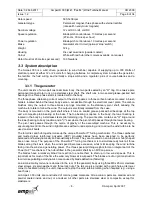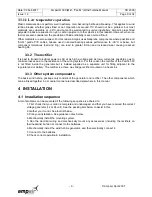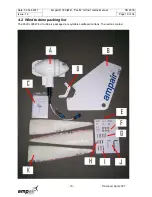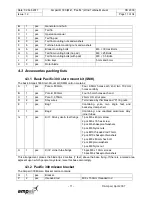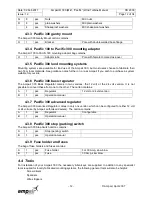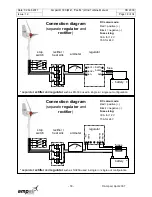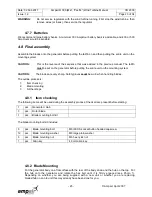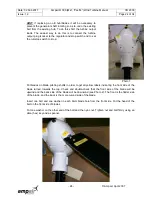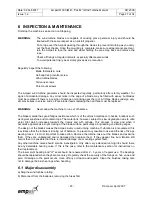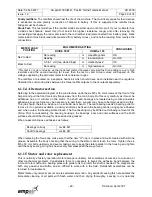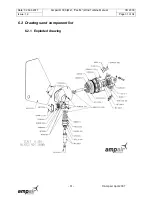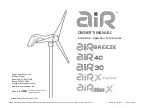
Date: 02 Feb 2011
Ampair ® 300 (Mk1, “Pacific”) Wind Turbine Manual
CD 2300
Issue: 1.2
Page 22 of 34
- 22 -
© Ampair, April 2007
4.7.6 Regulators
Ampair manufactures charge control regulators for protecting lead acid batteries from overcharge. They
are not "shunt" type regulators, which dissipate excess charge as heat, but an electronic power switch
which disconnects the generator from the battery at the regulation voltage. When the generator is
disconnected it will „freewheel‟ at a faster speed.
Three different regulators are available for the Ampair 300. The S-12-300 and the S-24-300 are
encapsulated regulators with integral rectifiers. They only have one input channel and one output channel.
The correct regulator must be purchased to suit the turbine and battery bank layout, i.e. 12 volt or 24 volt.
No user configuration is possible of the S-12-300 or S-24-300.
The battery voltage is sensed at the regulator output connection, therefore install the regulator as near the
battery as practicable and keep the connecting cables short. The regulators charging continuously until a
Lo or Hi voltage is reached, depending on the battery output used. The generator is then disconnected
from the battery. Off-charge the battery voltage will fall. At a voltage of 0.5V below the regulation voltage a
30-second time delay is activated. This delay prevents the regulator from oscillation (hunting) when
charging batteries under load.
The PR-300 is a user configurable regulator which must be installed with a separate external rectifier. It
can be configured as either a 12 volt unit or a 24 volt unit by inserting the appropriate fused links. It can
also be configured to provide either two inputs (two wind turbines or a wind turbine and solar panels) or
two outputs (two separate battery banks). The PR-300 regulator voltage set point can be adjusted using
internal links. In the PR-300 fuses are used in other links to set 12/24 volt operation and to determine the
input and output channels. The PR-300 has its own output fuse (i.e. no separate fuse is required in the
battery compartment). There are status lamps on the PR-300.
4.7.6.1
Installation of regulators
At initial start-up, allow a gap of 1 minute for circuit timing functions to become active.
Fuse Warning:
Never omit fuses, simple in-line fuse carriers may be used, they protect your system from
excessive battery currents in the event of a serious electrical fault. If they keep blowing, find out why.
The external fuses must be near to the battery terminals since, in the event of a fault, the batteries would
source the fault current. Check and double-check polarities before making connections, insert the fuses in
the fuse carriers last of all.
All multistage regulators are internally protected by an SAE cartridge fuse. These are not substitutes for
battery protection fuses.
Corrosion:
This is the enemy of all electrical connections, especially in marine environments. Site
regulators in a weather proof location, as dry as possible and splash proof. Inspect all terminations and
connections for signs of corrosion. Rectify by cleaning, remaking etc. Use tinned copper wire for extension
leads to prevent corrosion spreading inside cable insulation.
Operating Problems:
A digital multimeter is useful for checking operation/fault finding if no permanent
monitoring instruments are used. Battery voltage levels and those of the charging source can be read
directly. Charging current readings will require the multimeter to be installed in line. In this way currents
into and out of the regulator can be observed. Do not remove battery connections since regulator
operation depends on a very small supply current. If the regulator is suspect then it can be temporarily
bypassed by connecting the source positive direct to a battery positive. The negative connections are
common and do not need disturbing unless regulator replacement is necessary. Use the multimeter
continuity range to confirm all cable runs are low resistance.
Operation:
When installed, the generator and regulator will run and maintain the batteries automatically.
The unit may be run in conjunction with any other charge-source with no known interactive problems.
Regular battery inspection and topping up must still be carried out to obtain maximum battery life.
Faulty regulator ?
If the regulator is suspect, then it can be temporarily bypassed i.e. connect the
rectified output of the Ampair directly to the battery terminals observing correct polarity. If this reinstates
correct charging, then the regulator must be serviced or replaced. Regulators draw a small current
(typically 1mA at 12V; more on the PR-300 because of the status lamps) from the battery to activate the
sense and control circuits. Without this connection the regulator will be inoperative.

